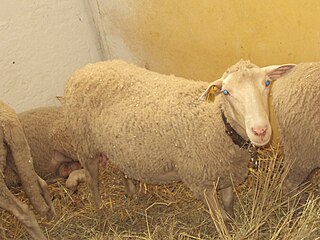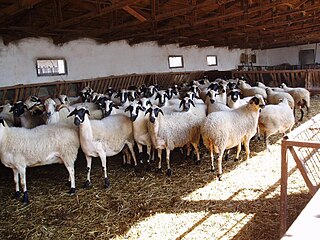
The Hampshire Down or Hampshire is a British breed of sheep. It originated in about 1829 from cross-breeding of Southdowns with the Old Hampshire breed, the Wiltshire Horn and the Berkshire Nott, all horned, white-faced sheep — these were native to the open, untilled, hilly stretch of land known as the Hampshire Downs. It is much used as a terminal sire.

The Bluefaced Leicester (BFL) is a longwool breed of sheep which evolved from a breeding scheme of Robert Bakewell, in Dishley, Leicestershire in the eighteenth century. First known as the Dishley Leicester, and then the Hexham Leicester, because of the prevalence of the breed in Northumberland, the name Bluefaced Leicester became known at the beginning of the 20th century. In the 1970s, the Bluefaced Leicester was exported to Canada. Exported frozen semen from the United Kingdom is now used to expand the genetic diversity in Canada and the United States. It is raised primarily for meat.

The Charollais is a breed of domestic sheep originating in east central France, in the same region in which Charolais cattle originated, Charolles and Saône-et-Loire. It is known for ease of lambing and is used as a terminal sire to increase muscling and growth rate of the lambs. It has been exported internationally, and is commonly used in the United Kingdom as a sire to produce market lambs from pure-bred ewes and mules.
The Debouillet is a breed of domestic sheep originating from Tatum, New Mexico. It was developed in the 1920s through crossing Rambouillet and Delaine Merino sheep and the breed's name is a portmanteau of these two ancestors. This breed is primarily raised for its wool.

The Basco-Béarnaise or Vasca Carranzana is a breed of domestic sheep originating in the Basque country. It was developed from Basque and Béarnaise sheep during the 1960s to be a single-purpose milk breed.
The Damani is a thin-tail, meat and wool breed of sheep which is found in the Dera Ismail Khan district and part of Bannu district in Khyber Pakhtunkhwa province of Pakistan.

Ruda is a breed of sheep found mostly in Albania and Croatia. In 2009, Ruda sheep is the most endangered breed of sheep in the Republic of Croatia. The Ruda sheep originated from the Romanian Tsigai, a fine fleeced sheep in the Balkans. The Ruda may be related to the Romanian Tsigai. This breed is primarily raised for wool.

The Algarve Churro or Churra Algarvia is a Portuguese breed of domestic sheep. It is distributed mainly in the Algarve and Alto Alentejo regions of southern Portugal, particularly in the arid Barrocal sub-region of the Algarve. It is primarily raised for its meat, although it also produces and is raised for carpet wool. Traditionally, it was also raised for its milk, used in cheesemaking, and for vegetation management. In subsistence agriculture, the traditional uses of the breed persist.
Altay is a breed of domesticated sheep originating in the dry, cold mountain basins of China. This breed belongs to the fat-rumped carpet wool type of sheep and the Kazakh group. Although the Altay grows wool, it is raised primarily for the meat.
Arabi is a domesticated breed of fat-tailed sheep from southwestern Iran, southern Iraq and northeastern Arabia and Egypt. Though it does grow wool, it is primarily raised for meat.

Askanian is a breed of domesticated sheep found in Ukraine. It is a fine-wool breed bred for its wool. It was developed by crossing American Rambouillet with Merinos in the early 1900s.
The Bibrik is a fat tailed, domesticated breed of meat sheep that is found in Baluchistan Province of Pakistan.

The Bizet is a domesticated breed of sheep originating from France. It grows wool but is primarily raised for meat. In 1952, the Bizet was introduced on the Kerguelen archipelago. It is utilized as food for the scientific station there.
The Bündner Oberländerschaf is a domesticated breed of sheep in Switzerland. As of 2007, there were less than 1,100 but the population is increasing and used primarily for vegetation management.

The Chios is a breed of domestic sheep with specific unknown origins. It is classified as a semi-fat tailed breed. The Chios are bred mainly for their milk production. Although there is speculation that this breed may have been crossed with Kivircik and Dagliç, it is commonly accepted that it originated on the Greek island of Chios.
The Cholistani is a breed of domestic sheep from Punjab, Pakistan. Though the Cholistani grows wool, it is raised primarily for meat.
The Cikta is a breed of domestic sheep from Hungary. In the 18th century, this breed was brought to Hungary by German settlers. This breed grows wool but is primarily raised for meat. The Cikta belong in the Mountain Group of sheep breeds.

The Coburger Fuchsschaf is a breed of domestic sheep from Germany. It is characterized by its reddish brown to golden color, which is most pronounced at birth, but remains at the head and the legs in the adult. Many animals also have a dorsal stripe.
The Comeback is a type of domestic sheep originating in Australia. This type of sheep results from crossbreds produced by British Longwool sheep and Merinos being mated back to Merinos. This cross is made to achieve a finer, better style of wool. Comeback style wool is also produced by Bond, Cormo and Polwarth sheep and they may prove easier to breed than Comebacks. The Comeback sheep are raised for meat and their fine wool.
Gaddi is a breed of domesticated sheep found in India. They are one of eight different breeds of sheep found in the northern temperate area of India. The Gaddi is raised primarily for its wool.










